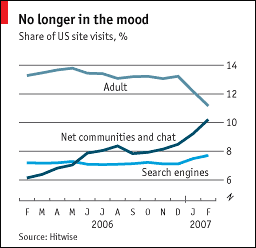Sex and the internetDevices and desires - Is lascivious online content, traditionally on top, losing its lustre?The Economist Apr. 22, 2007 |
Popular 
NYT: Trump Ended War With Houthis After They Shot Down U.S. Drones, Nearly Hit Fighter Jets

Trump Advisor to Washington Post: 'In MAGA, We Are Not Bibi Fans'

Ben Shapiro, Mark Levin and Laura Loomer Warn of Foreign Influence... From Qatar

Trump Cut Off Contact With Netanyahu Over 'Manipulation' Concerns, Israeli Reporter Claims

Trump Praises Houthis' 'Bravery'
  WHEN the internet took off in the 1990s, it was demonised as a steaming cauldron of porn. It has certainly made pornography more widely and easily available than ever before. The online porn industry is difficult to measure, but was valued at $1 billion in 2002 by America's National Research Council. Google, which publishes its “zeitgeist” list of top search queries, redacts sex-related terms from the rankings for fear of causing offence. But the popularity of pornography is clear from figures compiled by companies that track user “clickstreams”. Last year about 13% of website visits in America were pornographic in nature, according to Hitwise, a market-research firm. For comparison, search engines account for about 7% of site visits. WHEN the internet took off in the 1990s, it was demonised as a steaming cauldron of porn. It has certainly made pornography more widely and easily available than ever before. The online porn industry is difficult to measure, but was valued at $1 billion in 2002 by America's National Research Council. Google, which publishes its “zeitgeist” list of top search queries, redacts sex-related terms from the rankings for fear of causing offence. But the popularity of pornography is clear from figures compiled by companies that track user “clickstreams”. Last year about 13% of website visits in America were pornographic in nature, according to Hitwise, a market-research firm. For comparison, search engines account for about 7% of site visits.Yet the Hitwise data suggest that sex sites are now being dethroned. In Britain search sites overtook sex sites in popularity last October—the first time any other category has come out on top since tracking began, says Hitwise. In America, the proportion of site visits that are pornographic is falling and people are flocking to sites categorised “net communities and chat”—chiefly social-networking sites such as MySpace, Bebo and Facebook. Traffic to such sites is poised to overtake traffic to sex sites in America any day now (see chart). Does this mean the internet has matured as a medium? After all, pornographic content is often the first to take advantage of new media, from photography to videocassettes to satellite television. “Sex is a virus that infects new technology first,” as Wired put it back in 1993. Once a new medium becomes popular, its usage is no longer dominated by porn. Although this may soon be true for the web, however, it is not true for the internet as a whole. Much pornographic content may simply have shifted from the web to peer-to-peer file-sharing networks, for example. Or consider Second Life, the booming virtual world. It is regularly feted as a flourishing platform for virtual commerce, yet a large portion of its economic activity relates to sex. Exactly how much is unknown, but an employee of Linden Labs, the company behind Second Life, once ventured that 30% of transactions related to sex or gambling. Edward Castronova of Indiana University estimates that sex is “a substantial portion, perhaps even the majority” of economic transactions in Second Life. (Users must first buy genitalia for their avatars, who otherwise resemble Barbie and Ken dolls when unclothed.) The growing popularity of social-networking sites is not entirely unrelated to sex, either. Such sites are often used to find and attract potential mates. Porn sites may have reached a climax, but sex remains as potent online as ever. |



